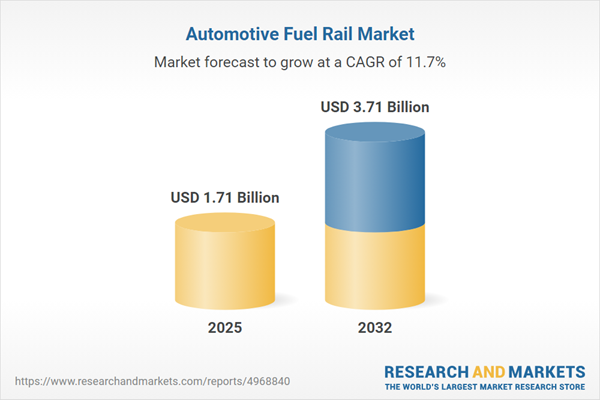Speak directly to the analyst to clarify any post sales queries you may have.
The automotive fuel rail market is evolving as regulatory mandates intensify and new propulsion systems emerge. Senior leaders recognize the urgency of enhancing supply chain resilience, innovating materials, and streamlining compliance to maintain their competitive edge in an accelerating industry.
Market Snapshot: Automotive Fuel Rail Market Growth and Trends
The global automotive fuel rail market is projected to advance from USD 1.52 billion in 2024 to USD 1.71 billion by 2025, reflecting a compound annual growth rate (CAGR) of 11.73%. Heightened focus on powertrain efficiency and stricter regulatory requirements have led manufacturers and suppliers, in both established and emerging markets, to realign investments and optimize development strategies. Leadership teams are lately overhauling procurement and research initiatives to ensure customer-specific compliance, fortify their market presence, and accelerate introductions of innovative vehicle platforms. The adaptive application of advanced technologies and new materials is proving vital for organizations navigating environmental imperatives and evolving automotive sector demands.
Scope & Segmentation: Comprehensive Automotive Fuel Rail Market Perspective
- Fuel System Types: Includes common rail systems and conventional alternatives, designed to address diverse vehicle platforms and injector performance needs.
- Material Types: Covers selections from die-cast aluminum, extruded aluminum, carbon steel, stainless steel, and plastic composites, balancing strength, cost, and reduced vehicle weight.
- Fuel Variants: Addresses diesel, gasoline, and hydrogen applications, fostering cleaner mobility and aiding compliance with emissions and electrification policies.
- Pressure Ratings: Accommodates a wide spectrum of fuel system requirements to serve varied customer and engineering standards.
- Vehicle Types: Serves passenger and commercial vehicles, enabling tailored solutions for operators and meeting specific segment expectations.
- Distribution Channels: Encompasses original equipment manufacturers (OEM) and aftermarket sales, providing flexible sourcing and sales opportunities for business expansion.
- Geographic Coverage: Engages regions including the Americas, Europe, Middle East & Africa, and Asia-Pacific, each marked by unique industry growth drivers and market priorities in countries such as the United States, Germany, South Africa, and China.
- Technology Adoption: Focuses on real-time diagnostics, smart sensors, additive manufacturing techniques, and thermal management systems, which contribute to system reliability and operational efficiency.
- Leading Participants: Features Robert Bosch GmbH, DENSO Corporation, Continental AG, BorgWarner Inc., Hitachi Automotive Systems, MAHLE GmbH, Vitesco Technologies, Magna International, Aisan Industry, and Keihin Corporation, each setting standards and driving technical progress.
Key Takeaways for Senior Decision-Makers
- Advanced, lightweight materials support modular vehicle platforms and align with international benchmarks for emissions and alternative propulsion technologies.
- Deployment of real-time diagnostics and software improves fleet maintenance planning, reduces unplanned downtime, and strengthens operational efficiency.
- Flexible use of composites and advanced alloys lets organizations adapt rapidly to changing regulatory requirements and fulfill sustainability goals.
- Increased collaboration between R&D and manufacturing functions enhances speed of technology transfer and overall organizational responsiveness.
- Strengthening supply chain agility—by forming local production alliances and regional partnerships—mitigates risks and creates new entry points in expanding automotive markets.
- Embracing modular system architectures and advanced analytics enables firms to align closely with shifting consumer and industry demands, driving adaptability and forward readiness.
Tariff Impact on Supply Chain Strategy
Recent U.S. tariffs on aluminum and specialty steel imports have pushed up material input costs for the automotive fuel rail supply network. To address these shifts, manufacturers are actively diversifying suppliers, investing in domestic capabilities, and developing strategic partnerships within major demand regions. These actions maintain supply stability and protect organizations from global cost fluctuations, while lean production methods help uphold cost discipline and ensure steady operations.
Methodology & Data Sources
This analysis integrates executive-level interviews, targeted end-user survey input, and detailed reviews of technical documentation. Findings are validated through proven industry protocols, ensuring senior management has actionable insights for confident strategic planning in the automotive fuel rail sector.
Why This Report Matters: Automotive Fuel Rail Market
- Provides actionable strategies to implement advanced technology, optimize sourcing, and enhance procurement, strengthening competitive positioning.
- Clarifies regulatory complexities at the regional level to help leaders stay ahead of compliance requirements.
- Supports the identification of scalable opportunities, enabling resilience and continuous innovation for automotive fuel system stakeholders.
Conclusion
This report equips leadership teams with clear, strategic guidance to proactively address change, foster operational resilience, and maintain momentum in the fast-evolving automotive fuel rail market.
Additional Product Information:
- Purchase of this report includes 1 year online access with quarterly updates.
- This report can be updated on request. Please contact our Customer Experience team using the Ask a Question widget on our website.
Table of Contents
3. Executive Summary
4. Market Overview
7. Cumulative Impact of Artificial Intelligence 2025
Companies Mentioned
The companies profiled in this Automotive Fuel Rail market report include:- Robert Bosch GmbH
- DENSO Corporation
- Continental AG
- BorgWarner Inc.
- Hitachi Automotive Systems, Ltd.
- MAHLE GmbH
- Vitesco Technologies Group AG
- Magna International Inc.
- Aisan Industry Co., Ltd.
- Keihin Corporation
Table Information
| Report Attribute | Details |
|---|---|
| No. of Pages | 180 |
| Published | October 2025 |
| Forecast Period | 2025 - 2032 |
| Estimated Market Value ( USD | $ 1.71 Billion |
| Forecasted Market Value ( USD | $ 3.71 Billion |
| Compound Annual Growth Rate | 11.7% |
| Regions Covered | Global |
| No. of Companies Mentioned | 11 |









